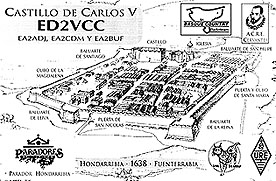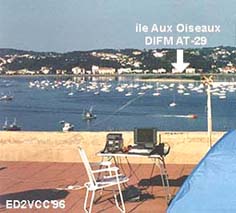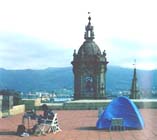 |  |
|---|
 |  |
|---|
|
CARLOS Vren GAZTELUA Herriaren goiko aldean finkatuta, dakigunez betidanik egondu da leku hortan antzeko fortifikazioren bat, kanpoko arerioren aurka zaintzeko. Santxo Abarka izan zen (X ren mendean), Nafarroko erregea izanez, arduratu zena birmoldaketa eta berriketa zuzentzea. Errege Katolikoen garaian ( XV mendean ), sekulako garrantzia artu zuen eta horrela jarraitu zuen bere illoba Carlos V rren enperadorearen garaia arte. Sekulako errege franko baliatu ziren gaztelu honetaz babeza bezala. Berez egikuntza nahiko berezia da, zorrotza, sendo egina, gela izugarriekin, eta hutsaldirik gabe, galtzen horrela garaia hortako gazteluen berezitazun aipagarrienak. XVI rren mendean frontera hurbiltasuna dela medio garrantzi izugarria eman zitzaion kanpo aldeko arerioren eraso bortitzei aurre egiteko. 1638 ko urtean Hondarribiak jasan zuen erasoak benetan frogatu zuen gazteluaren sendotasuna, dagoeneko Leyva eta Magdalenaren baluarteak guztiz txikituak izan ondoren mila eta berreun kañoi tiro jaso zituen frantses etzaiengandik baina ezin izan zuten gaztelua errenditu arazi. Gaur egun Hondarribiko Paradorea da. 
CASTILLO DE CARLOS V Situado en la parte alta de la actual villa, siempre debió de haber allí alguna fortificación, que la protegiera de invasiones desde los tiempos más remotos, siendo Sancho Abarca (siglo X), Rey de Navarra, quien la reconstruye y fortifica. En tiempos de los Reyes Católicos (siglo XV), cobra primordial importancia, continuando en época de su nieto El Emperador Carlos V. Sirvió de protección a numerosos reyes. Es una construcción singular, severa, de potentes muros, enormes naves, con escasez de huecos, que pierde los elementos típicos del castillo medieval, que la naciente artillería hace inútiles. En el s.XVI se le daba gran importancia por la próximidad de la frontera y su eficacia inmediata ante un ataque exterior. El de Fuenterrabía, en 1638, puso a prueba su fortaleza, ya que minados los baluartes de Leyva y la Magdalena, recibió en el asedio, más de mil doscientos disparos de cañones franceses, sin ser asaltado. En la actualidad es el Parador de Hondarribia.
LE CHÂTEAU DE CHARLES V Placé en haut sur la ville, il y eut toujours de fortification, pour se protéger des invasions. C´est le Roi Sancho Abarca de Navarre (Xème siècle) qui bâtit le château actuel. Il gaigna de l´importance au temps des Rois Catholiques (XV s.) et apres avec leur petit-fils, l’empereur Charles V; il fut aussi utilicé par de nombreuses rois. C’est une construction singulière, sévère, avec de gros murs, très grands nefs, pas beaucoup de fenêtres, et sans les elements des chateaux du Moyen Âge, rendues innécesaires à cause de la nouvelle artillerie. Pendant le XVI siècle joua un rôle important par sa proximité de la frontière et sa efficacité pour les ataques exterieures. En 1638, pendant son siège, il receva plus de mil deux cents coup de canon de la marine française, sans être assailli. Maintenant c’est le "Parador de Hondarribia" (Hôtel-Châteaux).
THE CASTLE OF CHARLES V Located in the higher part of present day Fuenterrabia where it resisted many invasions, there are clues of sorne kind of fortification from ancient times. King Sancho Abarka of Navarre (1Oth. century) rebuilt and fortified it. It becarne a place of prime importance at the time of the Catholic Kings (15th.Oentury) and su was also to their grand son King Cliarles V. Many other monarchs found shelter there as weII. It's a unique construction severe, with powerful walls and huge naves. It has few openings to the outside and Iacks some of the elements to be found in a typical castle. Those were no longer useful due to the appearance of artillery. Along the l6th. century it gained importance as a border outpost to stand attacks from outside of the country. During the 1683 siege and after the buIwarks of Leyva an Magdalena were destroyed it was the target of more than one thousand two hundred shells shot by the French army, without surrendering. At present it serves as the "Parador' (Inn) of Hondarribia.
|
|---|
